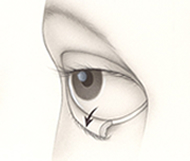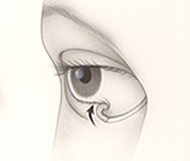Oculoplastics ~ Conditions
Droopy Eyelids (Ptosis)
Droopy eyelids, or eyelid ptosis, can make a person appear drowsy. In severe cases, the drooping lids can obscure one's vision. Many patients with eyelid ptosis complain of brow ache, as they must continually raise their eyebrows in order to see. When eyelid ptosis results from aging, the loss of vision may be gradual. However, children with droopy eyelids may have an underdeveloped eyelid muscle. In other cases, trauma or nerve damage can cause one or both eyelids to droop.
Treatment for Eyelid Ptosis
When drooping eyelids compromise vision, surgery may be necessary. Performed on an outpatient basis, eyelid surgery involves little recovery time. An ophthalmologist at our practice in New Jersey can evaluate each patient and recommend an appropriate treatment plan. If you are experiencing vision problems due to droopy eyelids, contact the eye care professionals at Westwood Ophthalmology today.
Ectropion

Treatment for Ectropion
Lubricating eye drops can help to alleviate the symptoms of dry eye caused by mild ectropion. If ectropion is more severe, however, surgical treatment may be recommended. During an outpatient procedure, the surgeon removes excess skin and tightens the eyelid muscles and tendons. He or she may use a skin graft for patients in which scarring is the cause of ectropion.
Entropion

Treatment for Entropion
If entropion does not resolve itself, surgery may be necessary to correct the condition and ease irritation. There are two surgical options for the treatment of entropion. A temporary solution may involve suturing the eyelid into its proper place. When a more permanent solution is necessary, the surgeon may surgically remove excess skin and tighten the eyelid muscles and tendons.
Tear Duct Obstructions
Occurring in adults as well as children, tear duct obstructions may develop for a number of reasons. Certain medications, inflammation, infection, polyps, and facial trauma can all cause a tear duct to become blocked. In some cases, a blocked tear duct can promote the accumulation of bacteria, which may lead to an infection. Tear duct obstructions in infants may occur if the child was born before his or her tear ducts were fully developed. Fortunately, infant tear duct obstruction tends to resolve itself by the time the child is one year old.
Treatment for Tear Duct Obstructions
Tear duct obstruction in adults may be treated by reconstructing the tear duct system. Also known as dacryocystorhinostomy (DCR), tear duct reconstruction involves the creation of a new passage between the nose and the lacrimal sac. A stent is usually placed in this new passageway to ensure that it remains open. Several months after surgery, the stent is removed during a routine check-up.

Connect With Us